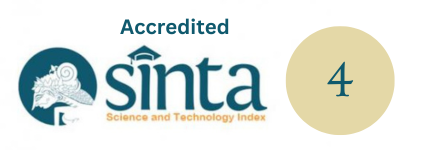Pelegongan Music Composition “Kasmaran | Komposisi Gamelan Pelegongan “Kasmaran”
DOI:
https://doi.org/10.59997/jurnalsenikarawitan.v2i3.458Kata Kunci:
Kasmaran, Gong Kebyar, Ubit-ubitan, Tri AnggaAbstrak
Wujud garapan ini merupakan sebuah tabuh kreasi petegak pelegongan yang berjudul “Kasmaran”. Ide garapan ini ditranformasi dari sebuah fenomena cinta kasih yang penata rasakan atau dari pengalaman pribadi. Karya seni karawitan ini menggukanan media ungkap Gong Kebyar serta dua tungguh gender rambat dan tidak menggunakan instrumen reong yang terdapat pada barungan Gong Kebyar, karena dilihat dari konteks gamelan Pelegongan tidak menggunakan instrumen reong. Wujud garapan ini tidak lepas dari unsur-unsur tradisi yang ada, garapan ini terdiri dari tiga bagian yaitu kawitan, pengawak dan pengecet. Penataan unsur musikal baik dari struktur lagu, teknik permainan maupun motif-motif gendingnya dikembangkan kembali dengan mengolah unsur-unsur musikal seperti nada, melodi, tempo, ritma dan dinamika. Selain hal-hal tersebut, sifat estetika umum seperti unity (keutuhan, kekompakan, kebersihan), complexity (kerumitan) dan intensity (kekuatan, kesungguhan, keyakinan) juga dijadikan acuan dalam mewujudkan garapan karya seni untuk memberikan bobot seni terhadap garapan karawitan Kasmaran yang berkualitas
Unduhan
Referensi
A.A.M.Djelantik. (2004). Estetika Sebuah Pengantar (2nd ed.). Masyarakat Seni Pertunjukan Indonesia (MPSI).
Dewantara, I. P. G. E. P., Suartaya, K., & I Ketut Garwa. (2021). Sangkameteng Karawitan Composition | Komposisi Karawitan Sangkameteng. GHURNITA: Jurnal Seni Karawitan, 01(01), 47–55. https://jurnal2.isi-dps.ac.id/index.php/ghurnita/article/view/212
Dibia, I. W. (2017). Kotekan Dalam Musik Dan Kehidupan Bali. Bali Mangsi Foundation dan ISI Denpasar.
Hawkins, A. M. (2003). Mencipta Lewat Tari. Terj. Y. Sumandiyo Hadi. Manthili.
Kariasa, I. N., & Putra, I. W. D. (2021). Karya Karawitan Baru Manikam Nusantara. Mudra Jurnal Seni Budaya, 36(2), 222–229. https://doi.org/10.31091/mudra.v36i2.1471
Muryana, I. K., Haryanto, T., Gede, I., & Widi, F. (2020). Eksistensi Gamelan Gong Luang Di Banjar Seseh Desa Singapadu. 6(November), 105–110.
Pryatna, I. P. D. H. S. (2020). Konsep Musikal Instrumen kendang Dalam Gamelang Gong Kebyar Bali. Resital: Jurnal Seni Pertunjukan, 21(2), 73–84. https://doi.org/10.24821/resital.v21i2.4220
Rianta, I. M. K. S. H. S. I. M., Santosa, H., & Sariada, I. K. (2019). Estetika Gerak Tari Rejang Sakral Lanang Di Desa Mayong, Seririt, Buleleng, Bali. MUDRA Jurnal Seni Budaya, 34(3), 385–393. https://doi.org/10.31091/mudra.v34i3.678
Saptono, Haryanto, T., & Hendro, D. (2019). Greng Sebuah Estetika Dalam Kerampakan Antara Gamelan dan Vokal. KALANGWAN Jurnal Seni Pertunjukan, 5(1), 29–38. https://doi.org/10.31091/kalangwan.v5i1.728
Supriyadnyana, P. G. W., Mustika, P. G., & Muryana, K. (2020). Pengantar Karya Komposisi Tabuh Kreasi Pepanggulan Amande. Kalangwan: Jurnal Seni Pertunjukan, 6(1), 16–25.
Yasa, I. G. J. M. Y. N. P. T. A. (2021). Tabuh Lelambatan Klakat Sudhamala: A New Creative Musical Composition | Tabuh Lelambatan Klakat Sudhamala: Sebuah Komposisi Karawitan Kreasi Baru. GHURNITA: Jurnal Seni Karawitan, 01(01), 37–46. https://jurnal2.isi-dps.ac.id/index.php/ghurnita/article/view/191
Yudha, I. N., Widiantara, P., Santosa, H., & Suartaya, K. (2020). Proses Penciptaan Komposisi Karawitan Kreasi Baru Paras Paros. 8(April), 1–13. https://doi.org/10.24821/promusika.v1i1.3607








